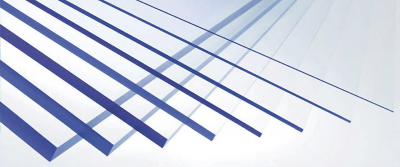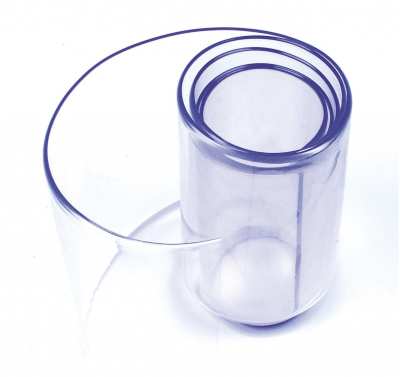Search products
Categories
Search product
Categories
PC - Polycarbonate
Brand: 
- Extremely high impact resistance
- High temperature resistance
- Good rating thanks to their fire reaction properties
Interested in this product?
Compact polycarbonate sheets are transparent, shiny, and UV-stabilised.
They offer excellent impact resistance in that they are far more resistant than other products in their class.
Compact polycarbonate sheets can resist temperatures ranging between -100 °C and +120 °C; they offer very good transparency and a good reaction to combustion.
Sheets come in the following versions:
- TRANSPARENT perfect visibility and high light transmittance;
- GLARE-FREE glare-free finish and very good resistance to UV radiation on one side;
- OPAL 30 or OPAL 50 translucent, combining good light diffusion and a pleasant white hue;
- SMOKED bronze or transparent grey;
- ADDITIVATED transparent, additivated with a flame retardant agent, with improved UL94 fire rating;
- FOOD / MEDICAL GRADE transparent, offering perfect visibility and suitable for contact with food and for medical applications.
BENEFITS OFFERED BY SHEETS
- Extremely high impact resistance
- High temperature resistance
- Good rating thanks to their fire reaction properties
APPLICATIONS
Typical applications of compact PC sheets include machinery guards, covers for ceiling lights and signage, door panels and walls.
Sheets offer protection against accidental breakage and intentional damage.
They can be thermoformed, cold bent, machined with ease.
| Properties | Standard | Test conditions | Unit of measurement | Value(1) |
| Physical properties | ||||
| Density | ISO 1183-1 | kg/m3 | 1200 | |
| Water absorption and saturation | ISO 62 | water at 23 °C | % | 0.3 |
| Water absorption and saturation | ISO 62 | 23 °C 50% Relative Humidity | % | 0.12 |
| Refractive index | ISO 489 | Procedure A | -- | 1.587 |
| Mechanical properties | ||||
| Tensile modulus | ISO 527-1-2 | 1 mm/min | MPa | 2350 |
| Yield strength | ISO 527-1-2 | 50 mm/min | MPa | >60 |
| Tensile strain at yield | ISO 527-1-2 | 50 mm/min | % | 6 |
| Tensile strain at break | ISO 527-1-2 | 50 mm/min | % | >50 |
| Modulus of elasticity | ISO 178 | 2 mm/min | MPa | 2350 |
| Flexural strength | ISO 178 | 2 mm/min | MPa | 90 |
| Charpy impact strength | ISO 179-1eU | 23 °C. unnotched | kJ/m2 | NB |
| Charpy impact strength | ISO 179-1eA | 23 °C. 3 mm. notched | kJ/m2 | 80P |
| lZOD notched impact | ISO 180-A | 23 °C. 3.2 mm. notched | kJ/m2 | 90P |
| Thermal properties | ||||
| Vicat softening temperature | ISO 306 | 50 N. 50 °C/h | °C | 148 |
| Thermal conductivity | ISO 8302 | 23 °C | W/mK | 0.2 |
| Coefficient of thermal expansion | ISO 11359-1-2 | 23 at 55 °C | 10-4/K | 0.65 |
| Deflection temperature under load | ISO 75-1-2 | 1.80 MPa | °C | 128 |
| Deflection temperature under load | ISO 75-1-2 | 0.45 MPa | °C | 140 |
| Electric properties | ||||
| Electric strength | IEC 60243-1 | 1 mm | kV/mm | 34 |
| Volume resistivity | IEC 60093 | -- | Ohm.m | 1.00E+14 |
| Surface resistivity | IEC 60093 | -- | Ohm | 1.00E+16 |
| Relative permittivity | IEC 60250 | 100 Hz | -- | 3.1 |
| Relative permittivity | IEC 60250 | 1 MHz | -- | 3 |
| Dielectric dissipation factor | IEC 60250 | 100 Hz | 10-apr | 5 |
| Dielectric dissipation factor. | IEC 60250 | 1 MHz | 10-apr | 95 |
(1)These values were measured on injection moulded specimen: they must not be used for specification purposes.
TRANSPARENCY
Test type: DIN EN ISO 13468-2
Standard formats are not available in all thickness options specified herein. Additional information is available upon request.
The data given are indicative and for reference only.
| Light transmittance (%) | 0,75 | 1 | 1,5 | 2 | 3 | 4 | 5 | 6 | 8 | 10 | 12 | 15 |
| Transparent | 90 | 90 | 89 | 89 | 88 | 87 | 87 | 86 | 85 | 83 | 82 | 80 |
| Glare-free | 83 | 83 | 82 | 82 | 80 | |||||||
| Opal 30 | 40 | 30 | 23 | 18 | 13 | |||||||
| Opal 50 | 60 | 50 | 40 | 33 | 28 | 20 |
AVAILABLE SIZES
Compact polycarbonate sheets are available in thickness from 0.75 mm to 15 mm and in the following sizes:
- 1250x2050 mm, up to 1.5 mm thickness;
- 2050x3050 mm.
Other sizes are supplied upon request and/or based on minimum order volumes.
WORKING TEMPERATURE
The maximum working temperature is approx. +120 °C.
| FIRE CLASSIFICATION(*) | ||||
| Country | Standard | Rating | Thickness | Colour |
| Germany | DIN 4102 | B1 (indoors) | 1-6 mm | Transparent |
| burning droplets | 2-3 mm | Opal 50 white | ||
| DIN 5510-2 | ||||
| S3 SR2 ST1 | 2-8 mm | Transparent | ||
| France | M2 | 1-15 mm | Transparent | |
| NF P 92-501&505 | ||||
| F1 | 0.75-15 mm | Transparent | ||
| NF F 16-101&102 | ||||
| Europe | EN 13501-1 | B s1 d0 | 1-6 mm | Transparent |
| B s2 d0 | 1-6 mm | All colours | ||
| USA | UL94 | V2 | 0.75-1.4 mm | All colours |
| HB | ≥1.5 mm | All colours | ||
| V0 | ≥10 mm | Transparent |
| GLOW WIRE FLAMMABILITY INDEX, IEC 60695-2-12, IN °C(*) | |||||||||
| 0.75 | 1 | 1.5 | 2 | 3 | 4 | 5 | 6 | 12 | |
| Transparent | 850 | 850 | 800 | 800 | 850 | 960 | 960 | 960 | |
| Opal 30 white | 900 | 960 | 960 | ||||||
| Opal 50 white | 960 | 960 | |||||||
(*) Fire reaction certificates have some time and scope limits. The certificate must always be checked for suitability on the shipment date with the type of sheet purchased. Polycarbonate sheets may, in fact, change their reaction to fire as a result of ageing and weathering. The specified classification was obtained by testing new sheets that had not been exposed to weathering, in accordance with the relevant classification standards.
Although the information provided in this product data sheet is confirmed by reliable research, POLITECNICA CETAI shall not take any responsibility for the application, processing or use of such information.


Share